 |
|
|
A Week in
Basalt & Lava Friday-Saturday, March 9-17, 2012 by Dennis Foster
Part II: In Lava and Back Out (Day 5 to Day 9) |
|
|
|
|
 |
|
|
A Week in
Basalt & Lava Friday-Saturday, March 9-17, 2012 by Dennis Foster
Part II: In Lava and Back Out (Day 5 to Day 9) |
|
|
|
|
|
|
|
|
See Bill Ferris' trip report at his website - Grand Canyon Adventure
|
|
Day 5 - Investigating another
route back to Basalt (Tuesday, March 13) -
It was colder last night, but no wind.
We were up at about 6:45 a.m. and ready to go two hours later.
There were still lots of mosquitoes plaguing us this morning.
But, Doug Nering suggested that an alternative route, just a little west of the obvious break, was not only an old miners' trail but was also Walcott's route. I wanted to check this out and after some consideration I agree with Doug's interpretation here, even though we may still differ on the exact track that this old trail took - see the competing photos below. I have addressed this issue more completely in the appendix below. It only took me about 25 minutes to hike up from our camp to the spot I had been the previous day, where you really get a great 360° view of Chuar. There is definitely an old trail up through the hillside to where the terrace starts to level out. I thought that this route may be faster than the one Bill and I used, but after having to cross two very large drainages I changed my mind on that score. Still, the hiking was just fantastic. Steep sections would often lead to grassy hanging valleys that were quite idyllic. I kept my focus on the old miners' route, which was also quite obvious. I found myself following deer tracks as I got closer and up at the base of the crumbing cliff I was able to follow a discernable, if faint, trail that switchbacked its way to the top of the ridge, which I reached just before noon. While I agree that this is likely the Walcott route, I did not see any definitive signs of trail construction; instead there was a beaten down path that looked well used. I did go over to the more obvious break and had no trouble getting down below the Tapeats cliff. But, from this break it is a bit sketchy along the top of this ridge heading up the canyon, while from the old miners' route it is clear sailing heading back towards the Lava-Basalt saddle. The ridge area here is rather narrow - it is only about twenty yards across. At 1:25 p.m. I was on my way to check out another Walcott issue. |
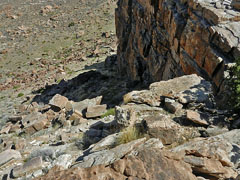 "Walcott's route?" follows cliff base. |
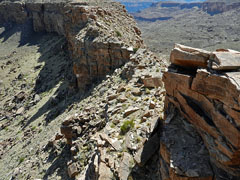 The top of "Walcott's route?" |
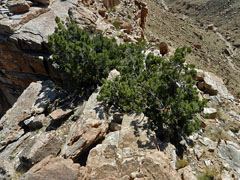 An obstacle for "Walcott's route?" |
|
My next objective was to follow the Tonto around the head of Basalt and investigate the first major ravine on the other side of this canyon for signs that Walcott used it as a temporary camp. I have written more thoroughly on this point in my appendix at the end of this page. Following their departure from Chuar, Walcott and Hamblin spent two nights on the Tonto "in a little canon beside a few shallow water-pockets." I am convinced that this was somewhere along the west side of Basalt. There are at least three good choices here - between Juno and Jupiter, out in front of Jupiter and between Jupiter and Venus. I had come up between Venus and Apollo in 2008 with Chris Forsyth and nothing seemed obvious as a camping spot, but that certainly would have been as far as Walcott would have traveled on the day they left Chuar. I knew I wouldn't have time to check out the whole area of interest, but I did have time to check out the first drainage past the head of Basalt, that runs between Juno and Jupiter Temples. It took me an hour to reach that little side canyon, with a bit of a shortcut across the top of Basalt. It looked like a good place to camp - the trees here would provide firewood for the men and there was a flat spot more than suitable for setting up camp. But, nothing definitive. I did see a big tree stump that looked like it might have been hacked off with an axe of some sort, but I can't be sure. I do not think that any miners roaming around this area in the years after Walcott would have spent any time on this side of Basalt. Although Walcott used it as a route to Unkar, it is faster/easier to follow at/near the river between Basalt and Unkar or to use the high pass from Lava into Unkar directly. I spent about 25 minutes looking around here and at 2:45 p.m. started heading back to Chuar. |
|
On my way back, I decided to cache a liter of water at a solitary tree, for the return trip tomorrow. Having covered this Walcott/miners route, I was sure that the route Bill and I followed into Chuar would be the best way to exit. It was 3:30 p.m. when I cached the water, 3:45 p.m. when I was down through the Tapeats, 4:45 p.m. when I was on the final slope that would go all the way to the creek, and 6 p.m. when I reached camp. It had been a full day. |
|
|
||
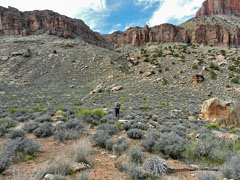 Bill heads up to Lava/Basalt break. |
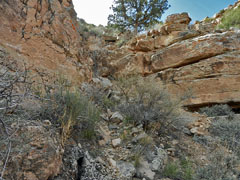 Cliff break near the top of route. |
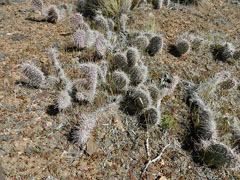 Cactus. |
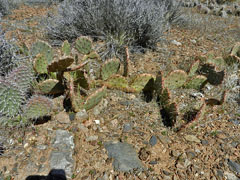 More cactus. |
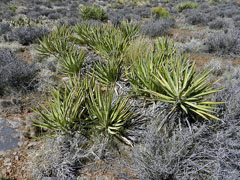 Yucca, which is kind of like cactus! |
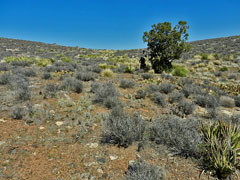 Rest break at my water cache tree. |
|
Day 8 - Two men and 3 packs to the top of the Redwall (Friday, March 16) - We were up at 6:15 a.m. and on our way by 8:30 a.m. Now the work really begins as the two of us have to haul up three packs - ours and the kayak. Bill took the first shift with the kayak. We hiked together up to the trail and then he dropped the kayak and returned to camp to get his pack. I hiked up to the top of the Redwall, where we would camp and then returned to meet up with Bill and take over the chore. We had reached the Tanner Trail at 9 a.m. and I had reached the Redwall camp at noon. I got back to Bill at 1 p.m. at the bottom of the Tapeats where he was having lunch and not doing well with the pack and the heat. I started the shuttling of the packs from here and was atop the Redwall at 4:45 p.m. Since we don't need the kayak with us, I hiked along the trail to the top of the next hill and then hung it up in a tree. It was windy and overcast late in the day and it was challenging to get the tents set up without them blowing away. We were both quite beat from the day's hiking and I was in my sleeping bag before dark. |
|
Day 9 - Out (Saturday, March 17) - The morning light was quite a sight. Bill was up and taking photos well before I crawled out of my tent. For this day I will do the shuttling of the packs and Bill will hike up to the trailhead and then come back to relieve me. I was on my way at 8:40 a.m. with some dark ominous clouds overhead. But, that didn't last and it was a fine day for our hiking. I picked up the kayak at 9 a.m. and hiked it to the giant rock campsite on the Esplanade by 10 a.m. Then it was back to my pack. Forty minutes later I had returned to the giant rock with my pack. I carried the kayak to a rest stop just past 75 Mile saddle and dropped it there. I returned with my pack by 12:30 p.m. and took a fifteen minute break. At about 1:30 p.m., while I was up in the Supai, Bill returned and took over on the kayak. Of course, now we can hike together since his pack was up at his car. We reached the top of the trail at 3 p.m. and fifteen minutes later we were in his car and heading home. |
|
|
||
|
|
||
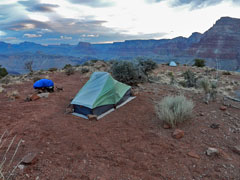 Redwall camp. |
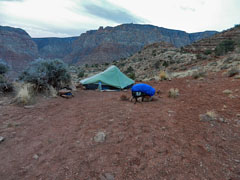 View of the Watchtower from camp. |
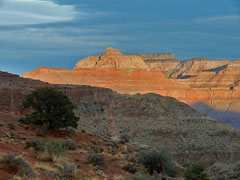 Vishnu Temple at sunrise. |
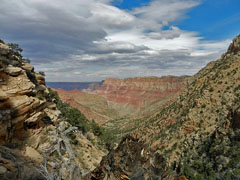 Looking down trail canyon. |
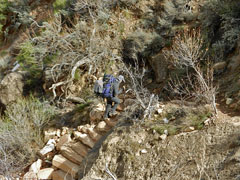 Bill w/kayak pack on Coconino steps. |
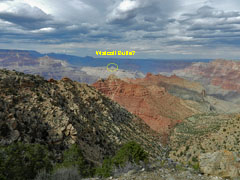 Looking back - Walcott Butte? |
| Once home I weighed the packs. My pack was 36 pounds and included 28 ounces of water. The kayak pack was 46 pounds and included about 20 ounces of water. |
|
|
|
|
|
|
See Bill Ferris' trip report at his website - Grand Canyon Adventure |
|
|
||
|
|
Return to Hiking Grand Canyon home page |
|